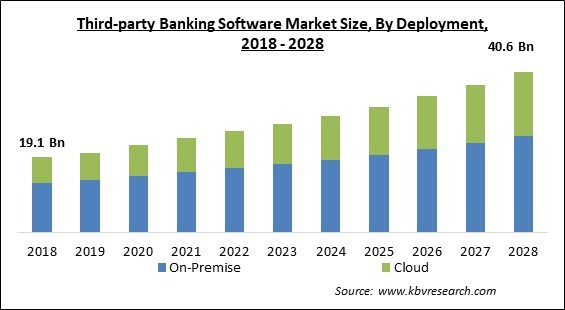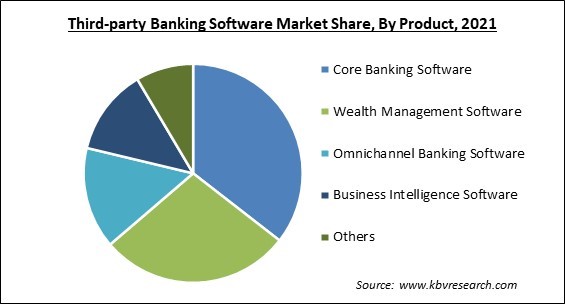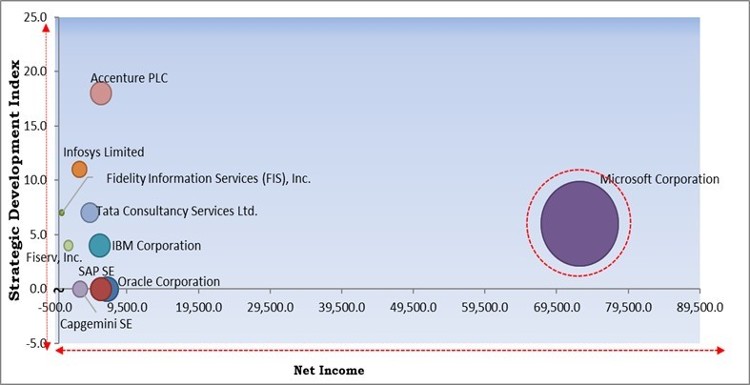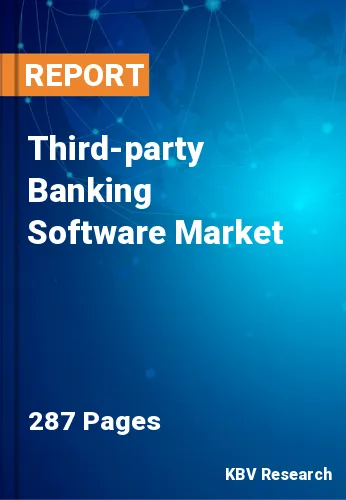The Global Third-party Banking Software Market size is expected to reach $40.6 billion by 2028, rising at a market growth of 8.0% CAGR during the forecast period.
A multi-channel program that handles several essential banking tasks, private wealth management, and business information are referred to as third-party banking software. The end-to-end omnichannel administration of banking operations is provided through an integrated and tailored software system. Commercial, retail, and trade banks utilize it largely to expand their interbank network and streamline their business processes.

The software helps to reduce losses brought on by human error, retain operational flexibility, enhance client satisfaction, and provide banks a competitive edge over rival financial institutions. The Core Banking, Multichannel, and BI segments make up the three major subgroups of the third-party banking software industry. Banks can offer their core banking services via a variety of channels due to third-party banking software providers.
As a result, banks are utilizing the advantages provided by third-party banking to transition to automated systems. Banks are becoming more and more reliant on mobile and internet channels as a result of their branch network contraction. As a result, it is becoming crucial for banks to give their consumers the choice to conduct financial operations quickly and securely using smart devices. This modernization process heavily relies on third-party banking software.
Positive growth effects are being produced by the increasing use of technologically sophisticated analytical tools like big data analytics. Large amounts of data must be processed effectively to make business decisions, spot market trends, and boost profitability. Being a data-driven enterprise, the banking sector relies on the use of third-party software connected with numerous analytical tools to manage data effectively.
The market for third-party banking software is expanding as a result of a transition from manual to computerized techniques for tracking and documenting financial transactions and bookkeeping. In keeping with this, the BFSI sector's increasing demand for process standardization and core banking systems is driving market expansion.
Particularly creating chances for the incorporation of third-party banking software is the increased demand for online banking solutions following the pandemic. Additionally, the development of online payment systems is enhancing the expansion of the sector. Digital financial services have been under the focus as a result of the COVID-19 pandemic and the requirement for social distance. Social isolation is made possible by digital financial services, which also enable governments to quickly and effectively provide money to people in need and give many households and businesses easy access to online transactions and financing.
The addition of analytics to third-party banking software is a significant component fostering the market's expansion. Due to the development of digital technology, consumers in the banking sector are altering how they access banking services. To communicate with businesses and obtain financial services, they are adopting mobile devices and digital technology. Due to this, the amount of client data held by businesses in the banking sector has increased exponentially. These businesses can examine the data they collect, enabling them to take quicker, more informed decisions that would increase efficiency across the board.
People worry about how reliable third-party software is. This is true if users seeking a program that will let them access every bank account they have. For many years, financial institutions have already earned the community's trust. Therefore, it is clear that financial organizations stand a higher chance of gaining customers' trust when viewed from the viewpoint of a bank user. For much third-party banking software, the hardest element would be attracting bank users and getting their permission to execute banking activities on their behalf.
It is one of the major obstacles preventing the market for third-party banking software from expanding. The main prerequisite for third-party banking software to provide highly effective and efficient operations is a powerful and high-quality network. Businesses using this software must have a reliable internet connection that enables them to function effectively in real-time. Furthermore, transferring data from connected devices like servers requires a lot of bandwidth. Additionally, businesses may suffer significant financial losses if the technology is unable to update real-time transactions, particularly in the investment banking industry.
On the basis of Product, the Third-party Banking Software Market is segmented into Core Banking Software, Omnichannel Banking Software, Business Intelligence Software, Wealth Management Software, and Others. The wealth management software segment registered a significant revenue share in the Third-party Banking Software Market in 2021. It is because as more people look for asset management services to assist them to generate enough retirement income, the need for third-party wealth management software is anticipated to be driven by the retired population.

Based on the Deployment Size, the Third-party Banking Software Market is divided into On-premise, and Cloud. The on-premise segment procured the largest revenue share in the Third-party Banking Software Market in 2021. It is because supremacy is ascribed to its simple customization possibilities, flexibility, and stronger security standards. After all, it operates on private servers.
By Application, the Third-party Banking Software Market is classified into Risk Management, Information Security, and Business Intelligence. The business intelligence segment witnessed a significant revenue share in the Third-party Banking Software Market in 2021. It is because the third-party banking software's business intelligence application helps banks make informed decisions based on information about trends and consumer behavior. The industry is also being driven by end users' increasing usage of data analytics to examine the data generated.
Based on the End-use, the Third-party Banking Software Market is bifurcated into Commercial Banks, and Retail Banks. The retail bank’s segment acquired the largest revenue share in the Third-party Banking Software Market in 2021. Retail banks are predicted to have an increasing demand for third-party banking software as it lowers operating expenses. Furthermore, due to the effective and unified system of retail banking software, the needs of the clients are better recognized.
| Report Attribute | Details |
|---|---|
| Market size value in 2021 | USD 24 Billion |
| Market size forecast in 2028 | USD 40.6 Billion |
| Base Year | 2021 |
| Historical Period | 2018 to 2020 |
| Forecast Period | 2022 to 2028 |
| Revenue Growth Rate | CAGR of 8% from 2022 to 2028 |
| Number of Pages | 287 |
| Number of Tables | 443 |
| Report coverage | Market Trends, Revenue Estimation and Forecast, Segmentation Analysis, Regional and Country Breakdown, Competitive Landscape, Companies Strategic Developments, Company Profiling |
| Segments covered | Product, Deployment, End-use, Application, Region |
| Country scope | US, Canada, Mexico, Germany, UK, France, Russia, Spain, Italy, China, Japan, India, South Korea, Singapore, Malaysia, Brazil, Argentina, UAE, Saudi Arabia, South Africa, Nigeria |
| Growth Drivers |
|
| Restraints |
|
Region-wise, the Third-party Banking Software Market analyzed across North America, Europe, Asia Pacific, and LAMEA. The North America region procured the highest revenue share in the Third-party Banking Software Market in 2021. It is due to the rising popularity of third-party software to boost operational effectiveness. Additionally, the presence of numerous significant businesses like Microsoft and IBM is anticipated to create a favorable picture for the industry's growth.
Free Valuable Insights: Global Third-party Banking Software Market size to reach USD 40.6 Billion by 2028

The major strategies followed by the market participants are Partnerships. Based on the Analysis presented in the Cardinal matrix; Microsoft Corporation is the forerunners in the Third-party Banking Software Market. Companies such as Accenture PLC, Infosys Limited, IBM Corporation are some of the key innovators in Third-party Banking Software Market.
The market research report covers the analysis of key stake holders of the market. Key companies profiled in the report include Microsoft Corporation, IBM Corporation, Oracle Corporation, SAP SE, Tata Consultancy Services Ltd., Infosys Limited, Accenture PLC, Capgemini SE, Fidelity Information Services (FIS), Inc., and Fiserv, Inc.
By Deployment
By Application
By End-use
By Product
By Geography
The global Third-party Banking Software Market size is expected to reach $40.6 billion by 2028.
Analytics Integration With Third-Party Banking Software are driving the market in coming years, however, Inadequate Internet Access In Poor Nations restraints the growth of the market.
Microsoft Corporation, IBM Corporation, Oracle Corporation, SAP SE, Tata Consultancy Services Ltd., Infosys Limited, Accenture PLC, Capgemini SE, Fidelity Information Services (FIS), Inc., and Fiserv, Inc.
The expected CAGR of the Third-party Banking Software Market is 8.0% from 2022 to 2028.
The Risk Management segment acquired maximum revenue share in the Global Third-party Banking Software Market by Application in 2021 thereby, achieving a market value of $19.7 billion by 2028.
The North America market dominated the Global Third-party Banking Software Market by Region in 2021, and would continue to be a dominant market till 2028; thereby, achieving a market value of $13.5 billion by 2028.
Our team of dedicated experts can provide you with attractive expansion opportunities for your business.

